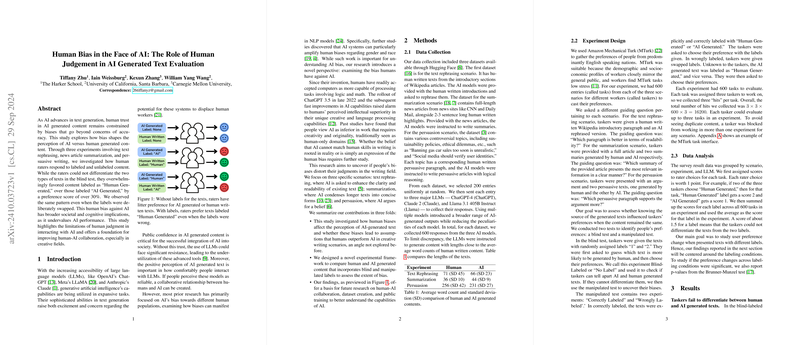Human Bias in the Evaluation of AI-Generated Text
The paper "Human Bias in the Face of AI: The Role of Human Judgement in AI Generated Text Evaluation" by Zhu et al. investigates the human biases that influence the perception and evaluation of AI-generated text. This research is of particular significance as LLMs increasingly permeate everyday tasks involving text generation, yet are met with skepticism from users who perceive AI-generated content differently than human-produced text.
Key Findings
Through three distinct experimental scenarios—text rephrasing, summarization, and persuasive writing—the paper reveals that human evaluators under blind conditions could not consistently distinguish between human and AI-generated text. Despite this difficulty, evaluators displayed a notable preference for text labeled as "Human Generated" by a margin exceeding 30%, even when the labels were incorrect. Such biases suggest a perception issue where AI-generated content is undervalued simply due to its origin, highlighting substantial implications for human-AI collaboration.
Methodology
The paper employed a series of experiments, using Amazon Mechanical Turk to gather initial human assessments across three scenarios. Data was collected from AI models (ChatGPT-4, Claude 2, Llama 3.1) and compared against human-generated text of similar length. Preference scores from raters were used to determine how bias influenced evaluations when texts were explicitly labeled, manipulated, or blindly labeled.
Implications
The findings point towards cognitive and societal biases that undervalue AI outputs despite their comparable quality to human-produced content. These biases pose challenges not only in the broader acceptance of AI technologies but also in AI system training processes like Reinforcement Learning from Human Feedback (RLHF). Understanding these biases can lead to more effective strategies for deploying AI technologies in human-centric scenarios.
Practical Applications and Future Directions
To promote better human-AI collaboration, the paper advocates for transparency and clarity in AI operations, perhaps through developing explainable AI systems. Furthermore, positioning AI as an assistive, rather than competitive, technology may help mitigate biases. Future research may explore how biases manifest in other creative domains or tackle the psychological roots of such biases, potentially attributed to a resistance to conceding the human domain of creativity to AI.
Limitations
Potential limitations include the demographic restrictions associated with using MTurk and the scenarios specific to writing tasks. Expanding future studies to encompass diverse demographic samples and additional creative contexts could yield a more comprehensive understanding.
In conclusion, this paper exposes a notable discrepancy in human evaluations of AI-generated text, rooted in bias rather than content quality. This insight into human judgment enriches the discourse on how AI technology is integrated and accepted across various domains of human activity.
